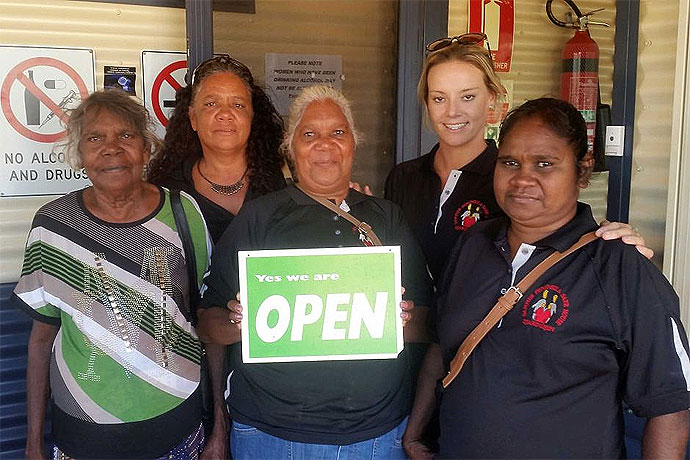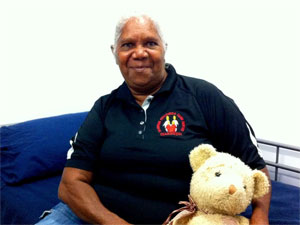Funding cut for remote Aboriginal domestic violence shelter will 'put lives at risk'
There is not a skerrick of evidence that abused women would be better off in larger towns and cities than in Homeland communities, everyone knows that domestic violence is accelerated where alcohol is easily accessible.
The 'Federal' and State governments failure to protect women or to address the 'hopelessness' associated with generational suppression and devaluation will continue to take its toll until governments face their responsibilities to its citizens and not just to large corporations.
Government's failure rates regarding their feeble attempts to protect women from domestic violence in towns and cities is a testament to their lies, contempt and disregard of the victims welfare and the mental state of the perpetrators.

PHOTO: Yvonne Sampi (centre) with the women who help run the Djarindjin Safe House 17 May 2015
(ABC News: Erin Parke)
Erin Parke and Lucy Martin ABC News 18 May 2015
A domestic violence shelter servicing 50 Aboriginal communities in the remote north of Western Australia has emerged as the latest project to miss out on funding under the Federal Government's overhaul of Indigenous funding.
The women who run the Djarindjin safe house say they will have to shut their doors on June 30, if the decision is not reversed.
Manager Dawn Thompson said lives would be put at risk by the funding cut.
"There are ongoing cycles of family violence in the area," she said.

(ABC News: Lucy Martin)
"The nearest other facility is in Broome, which is two-and-a-half hours away, and it's inaccessible because a lot of the women don't have cars.
"So these women and children will be put at risk of family violence."
The safe house was built at the Djarindjin community, 200 kilometres north of Broome, in 2014.
It services the women and children of four large Aboriginal communities and dozens of bush out-stations on the Dampier Peninsula.
The project was driven by local women, who had themselves been the victims of domestic violence and wanted to find a way to protect the younger generations.
One of those women was Yvonne Sampi, who was in an abusive relationship for 30 years.
"It was very hard, because I had to protect the kids first and protect myself later," she said.
"The kids had to run away to family members, while I used to get beaten.
"Family knew about it, because I wouldn't home to see my family for a couple of days because I was beaten up too much."
The dynamics of remote community life made it hard to find a house without links to her abuser.
Older women like Bernadette Angus would try to help, but doing so put their own families at risks.
"I'd hear them knock at my door, and they'd come through, and sit with me, they would be so tired," Ms Angus said.
"They were so nervous because their husband might be coming behind with a stick, or things like that, especially when it's dark, and they be intoxicated with the grog."
The women say they were proud and relieved when their campaign for improved safety paid off and they were able to open the doors of the four-bedroom women's safe house.
The facility has a top-notch security system and four brightly-decorated bedrooms.
The Federal Government contributed $500,000 towards setting it up and provided $180,000 for running costs.
Indigenous Advancement Strategy
Last year, the Djarindjin women applied under the Federal Government's new Indigenous Advancement Strategy to have their funding renewed.
Their application, made through the not-for-profit group Save the Children, was knocked back.
Ms Thompson said the women were devastated.
"To be honest, we were shocked, because this is an essential service," she said.
"Since we opened, we've provided a safe place for 60 women and children, so it's something that's badly needed."
Djarindjin Community Council chairman Brian Lee is furious.
He said the safe house project aligns perfectly with the Federal Government's stated aims of promoting community safety and local employment, and they have been given no explanation of why their funding application was unsuccessful.
"We're in the situation of telling four or five women that after a month, they don't have a job," Mr Lee said.
"And if it's not funded, we have to tell the women who come here to be safe that we can't help them anymore, that we cannot keep them safe, all because there is no funding to the safe house running.
"It makes me angry when you know there's $4.9 billion coming into Indigenous funding, and you can't get anything for something like this."
A flawed system?
To those who have been monitoring the roll-out of the Indigenous Advancement Strategy, the plight of the Djarindjin safe house comes as no surprise.
The strategy was launched last year to streamline Indigenous funding into five categories: jobs and economy, children and schooling, safety and wellbeing, culture and capability and remote Australia strategies.
To date, $860 million in funding had been allocated to almost 1,000 organisations
But it has attracted criticism for seemingly favouring large, non-Indigenous organisations; confusion over the application process; and long delays in making funding decisions.
Greens senator Rachel Siewert has successfully campaigned for a Senate inquiry into the process.
"It was chaotic, and anyone you speak to will tell you the same thing," she said.
"Short notice, not a lot of guidance, not a lot of support or information and clearly the assessment process has been flawed.
"It's really important that we go back and look at this program, because it's a mess, and it's essential that those gaps are identified and addressed and we learn from this and never let it happen again."
A spokesperson for Indigenous Affairs Minister Nigel Scullion said the Dampier Peninsula Safe House has funding through the Department of the Prime Minister and Cabinet until June 30, 2015.
"The safety of women in the Djarindjin community is of paramount importance so the Australian Government is working closely with Save the Children to refine its proposal for future funding."

